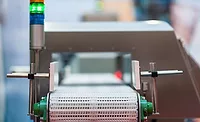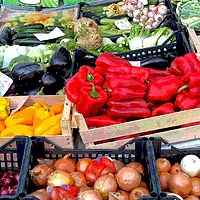Foreign-object contamination: Under the radar
Despite the advances in X-ray and metal detection systems, keeping meat and poultry totally free of foreign objects remains an ongoing processor challenge.

Technology is not the end-all when it comes to safeguarding meat and poultry from foreign-object contamination.
While detection devices remain strong preventative tools, the plethora of elements that can contaminate proteins is making it virtually impossible for producers to totally eliminate all incidents, analysts note. Such objects include animal bone fragments and cartridge, wood, metal shards and slivers, glass, plastics, rubber, pieces of scouring pads and buckshot from people shooting animals.
Many foreign objects originate from worn machinery, packaging, cleaning utensils, such as scrub brushes that lose bristles, and processing tools, including knives, tongs and cutting boards. In addition, wires and tags that ranchers use to identify cattle also can penetrate meat, says Jeff Nelken, a Woodland Hills, Calif.-based food safety consultant.
“There also are opportunities for foreign objects to enter into live animals from where they are housed,” he notes. “Cattle can chew on materials that get brittle or break over time, such as wires from cages, as well as splintered wood and the nails and plastic that are part of mechanisms that dispense food and water.”
The impact of foreign-object contamination can be costly from both a financial and reputational standpoint and incidents are ongoing. Last August, for instance, Corpus Christi, Texas-based Sam Kane Beef Processors had to recall 60,350 pounds of ground beef because of possible metal contamination, the U.S. Department of Agriculture’s Food Safety and Inspection Service (FSIS) reports.
The beef in three-pound, five-pound and 10-pound chub packages were shipped to three grocery distribution centers that San Antonio-based H-E-B operates in Texas. Spurring the recall was a consumer’s complaint about a small piece of metal in a product.
In addition, last September, Springdale, Ark.-based Tyson Foods recalled approximately 132,520 pounds of fully cooked chicken nuggets that were produced at its Sedalia, Mo.-plant because of concerns that the items might be contaminated with hard plastic, according to the FSIS.
Looking for quick answers on food safety topics?
Try Ask FSM, our new smart AI search tool.
Ask FSM →
The plastic, ranging from 21 millimeters in length and 6.5 millimeters in diameter, may have come from a round, hard plastic rod that connects a plastic transfer belt, the FSIS notes. While Tyson reports the chicken products did pass through a metal detector, the plastic is not detectable by the technology, the FSIS states, adding that consumer complaints uncovered the issue.
In March, meanwhile, OK Foods, a Fort Smith, Ark.-based chicken producer, began recalling 933,272 pounds of breaded chicken that may have been contaminated with metal objects, the FSIS reports. After receiving five consumer complaints, the company’s internal investigation found that the objects came from metal conveyor belting, the FSIS adds.
A constant battle
Because of the massive volume of meat and poultry that producers handle daily, plant operators will never be able to prevent all occurrences, analysts say. “There are just too many opportunities for foreign materials to come in contact with meat and poultry,” says Jeff Sindelar, associate professor and extension meat specialist in the Department of Animal Sciences at the University of Wisconsin in Madison. “Technologies also are never 100 percent effective so it would be an incorrect attitude and approach to see them as being the end-all.”
Though it is important that processors avoid complacency and continually work to enhance their foreign-object detection programs and quality assurance strategies, “keeping that a priority can be difficult as there are so many other priorities in production plants,” he says.
A key issue for operators is finding the time and resources to give all workers the necessary training to help thwart contamination or at least recognize the safety risks in their facilities, says Domenic Pedulla, president of the Canadian Food Safety Group, a Calgary-based food safety consulting and program development firm.
The large employee turnover in meat and poultry plants makes it particularly difficult for operators to keep all workers up to speed on detection skills.
“It’s a big, hard challenge to prevent foreign-object contamination, but that doesn’t mean processors should not do everything they can to prevent occurrences,” Pedulla says. “A major factor in increasing object detection is having proper plant inspections and asking, ‘Do our employees know how to use the equipment? Do they know how to raise concerns? Do they know when it is time to replace their utensils, knives, cutting boards and anything else that can cause contamination?‘ If they are not working at that, more food recalls are likely to occur.”
Educating workers on the importance and techniques of foreign-object detection is critical as human involvement is the main cause of contamination in meat and poultry products, says Mike Hayes, lead auditor, food supply safety, for NSF International, an Ann Arbor, Mich.-based food safety auditing firm and standards developer. Problems often result, he says, from the failure of employees to consistently follow proper operating procedures, often because of burdensome plant and equipment designs.
“The complexity and size of machinery used along production lines can limit operator accessibility for inspection, maintenance and cleaning,” he says, noting such elements also can hinder workers from quickly shutting down, disassembling and scrutinizing apparatus if they suspect foreign object contamination.
While a root cause analysis can help pinpoint the most likely sources of foreign matter, there are no prevention techniques that will eliminate all occurrences, Nelken says, adding that even the most advanced technologies “are not foolproof.”
Optimism has a price
A bigger challenge for operators is overcoming the false sense of food safety security that comes from scanning meat and poultry products with X-ray and metal detection systems, Sindelar adds. “There is a whole laundry list of items, such as glass, latex gloves, wood and other types of raw materials that the technologies may not detect and can result in product recalls,” he says. “Having the attitude of ‘I have a metal detector so I’m in good shape’ can create some potential concerns.”
To achieve the best results from screening equipment, it is essential that workers continually calibrate devices so the technologies align with the specific types of meat and poultry under scrutiny, he says. “Foreign-object detection is a fairly complex system which requires processors to always fine tune their equipment,” Sindelar says.
Even such elements as grind size can affect machine accuracy if operators do not perform the necessary programming.
“X-ray machines are delicate pieces of equipment and operators need to check the parameters of the devices every couple of hours because the need for accuracy is vital,” Nelken says. “The technologies are very sensitive and similar in operation to microscopes in that users must continually twist and turn and situate the equipment at the proper angle for proper readings. It requires a lot of adjusting and monitoring by plant workers.”
The difficulties of detection
Maintaining the proper machine calibration is fundamental if processors are to detect the foreign materials that have a similar density as meat and poultry products, such as bone, cartridge and wood.
Aluminum and stainless steel also can be difficult to detect in meat and poultry because the objects lack the iron content devices are programmed to identify, Nelken says.
In addition, because metal detection relies on identifying different electrical conductivities for the product and the metal, it can be hard to pinpoint objects in proteins with high levels of electrolytes, such as salt cured meats, processed meats and hams, Hayes says.
While metal detection and X-ray equipment have performance shortcomings, the devices also can be expensive to leverage. Metal detectors, for instance, often cost more than $25,000, while X-ray machines frequently are between $50,000 and $75,000, Sindelar says.
“That is a large investment for some plants,” he says. “The issue is all about analyzing risk and reward in deciding how much to invest in foreign-object detection programs, but the equipment can be cost prohibitive.”
Yet, even processors with the necessary means sometimes have the dilemma of not understanding which apparatus is best suited for their specific situations. “It is a common problem when plant operators are new to an industry,” Pedulla says. “They often behave like they did in previous, unrelated sectors and mistakenly believe their actions are proper.”
In addition to the equipment issues, dealing with perilous plant conditions and the emphasis by processors on achieving greater operating efficiencies often adds to the difficulties in accurately detecting and reducing foreign object contamination, Pedulla says.
Substandard lighting in plants and the swifter movement of products along production lines, for instance, can hinder employees from visually spotting irregularities in meat and poultry. “Problems often occur when there is a push for productivity over quality,” he says.
A cornucopia of contaminants
The contamination threats, meanwhile, will likely remain prevalent as the sources of contaminants in meat and poultry facilities are abundant. That includes deteriorating plant ceilings, walls, plumbing and even coverings of lighting fixtures, which all contain elements that can flake into proteins, Nelken says.
“Rust that accumulates in overhead pipers or shelving, as well as light bulbs that can break or explode, also can result in contamination,” he says. “And any machine that vibrates may cause screws or bolts to loosen and end up in the meat or poultry.”
In addition, the fine needles that plants use to tenderize proteins can easily break off from machines and the multitude of staples that hold together the plastic or metal belts that move products along processing lines can sever. Both elements are difficult to detect in proteins, analysts say.
“Equipment and facilities can be safety challenges, particularly if the apparatus and buildings are old,” Pedulla adds.
Solutions, meanwhile, can be laborious, such as the need to routinely inspect processing equipment for signs of pitting, grooving, cracking and other indicators of deterioration that might contribute to the migration of foreign objects into meat and poultry, Hayes says.
“The risks of objects originating from metal shavings, cracked or deteriorated surfaces, or particulates from corrosion is increased when proper sanitation and lubrications schedules are not followed,” he adds.
The challenges facing meat and poultry processors in minimizing foreign-object contamination are steep. While detection technologies are eliminating much of the risk, the inability of devices to pinpoint all objects and the multitude of threats along the supply chain will remain major burdens for safety-conscious producers.
“There is a high cost for operators to do food processing well,” Pedulla says. NP
This article was originally posted on www.provisioneronline.com.









